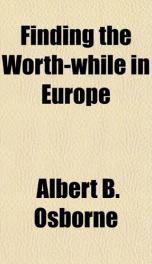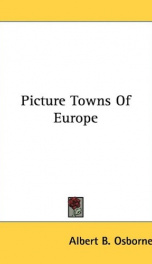finding the worth while in europe

Purchase of this book includes free trial access to www.million-books.com where you can read more than a million books for free. This is an OCR edition with typos. Excerpt from book: CHAPTER III HOLLAND AND BELGIUM NOT so very long ago, as history is written, these two nations were one and were dissolved into their present component parts only in the hot crucible of war. It was 1830 when the two went their several ways. Topographically they have yet much in common, but there is much more wherein they differ radically. In Holland the people are more picturesque, in Belgium the cities are more interesting than are the men and women who live in them. To both lands has descended a heritage of art, a heritage so important, indeed, that no matter how indifferent the traveler may be to the painted picture, he can make no plans for a visit, no matter how brief, to these lowland countries without allotting a large proportion of his time to a study, or at least inspection, of the masterpieces in churches and galleries. This book cannot be everything, and lays no claim to be aught save a counselor and friend, so I shall attempt no treatise on Dutch art, which like most laymen, I am incompetent to write, but will content myself by saying that Esther Singleton's "Guide to the Great Galleries" is satisfying and reliable, and contains all that the tourist who seeksimpressions of country and people rather than art, will generally demandthat, and your Baedeker. There are divers ways to cross from London to both Holland and Belgium, but for our purpose the night boat from Queensboro to Flushing is the most convenient. No better boats cross the Channel on any route. The boat train leaves London after dinner, and you can be in your berth at an early hour, and at dawn you are alongside the pier at Flushing. It is unnecessary to leave the steamer at that time, however, but you can dress leisurely at a more convenient moment, breakfast on board, and then take train or tram...
Info about the book
Author:
Series:
Unknown
ISBN:
1436964970
Rating:
2.5/5 (5)Your rating:
0/5
Languge:
English
Users who have this book
Users who want this book
What readers are saying
What do you think? Write your own comment on this book!
write a commentif you like finding the worth while in europe try:
Other books by this author
Do you want to read a book that interests you? It’s EASY!
Create an account and send a request for reading to other users on the Webpage of the book!



